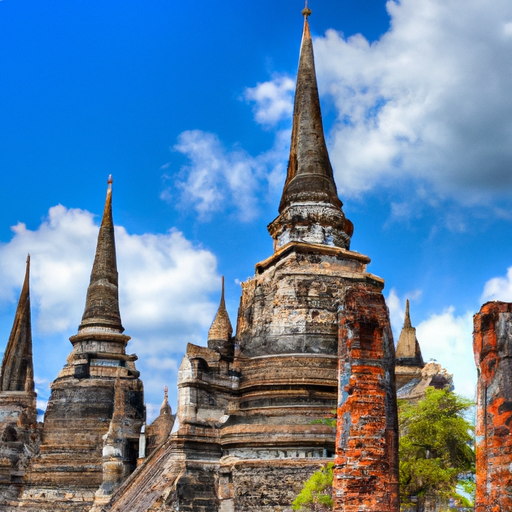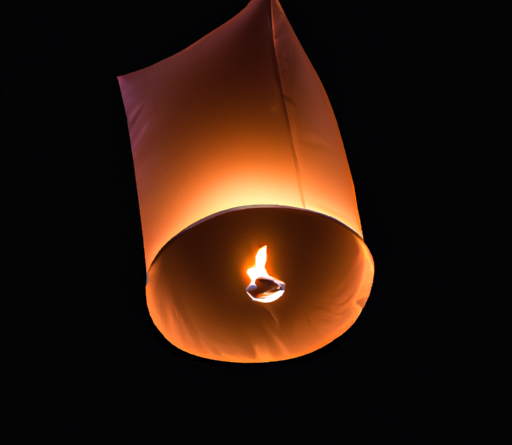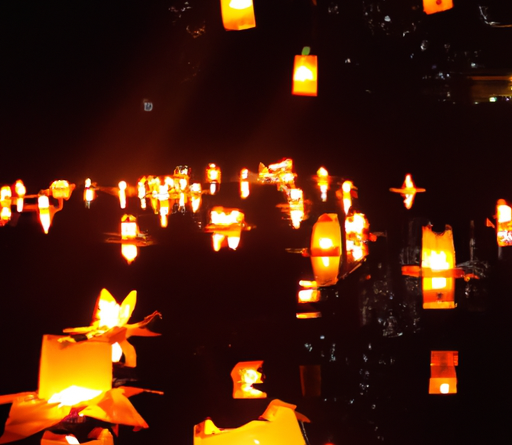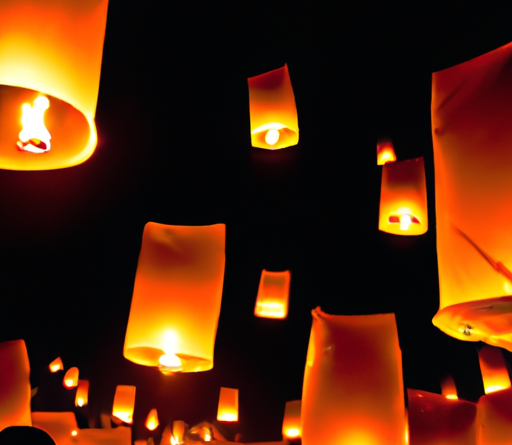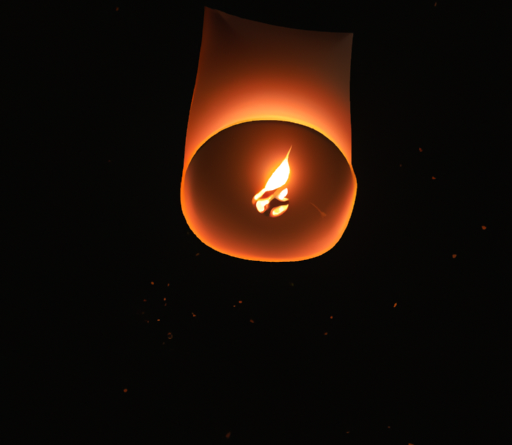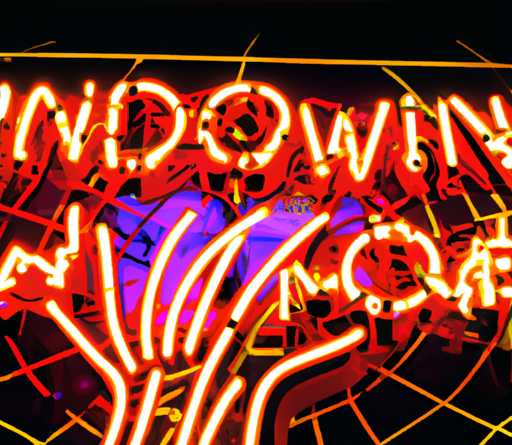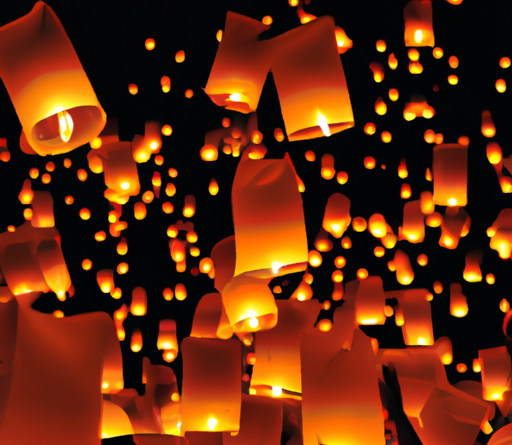
Thailand’s nighttime cultural festivals offer a vibrant and enchanting experience that should not be missed. From the shimmering lights of the Loy Krathong festival to the mesmerizing performances of the Yi Peng lantern festival, these events showcase the rich heritage and traditions of Thailand. Immerse yourself in the beauty of these festivals by participating in the floating lantern ceremonies, tasting delicious street food, and witnessing breathtaking fireworks displays. Discover the key tips and tricks for making the most out of your visit to these enchanting celebrations and create memories that will last a lifetime. Prepare to be captivated by the magic of Thailand’s nighttime cultural festivals.
Planning Your Trip to Thailand
Researching the Best Time to Visit
When planning your trip to Thailand, it’s crucial to consider the best time to visit this beautiful country. Thailand experiences three main seasons – the hot season, the cool season, and the rainy season. The hot season, which lasts from March to June, is characterized by high temperatures and humidity. The cool season, from November to February, offers more pleasant weather with cooler temperatures, making it an ideal time to explore the country. The rainy season, from July to October, brings occasional showers, but it also has its own unique charm. By researching and understanding the different seasons, you can choose the best time to visit based on your preferences and the activities you want to engage in.
Booking Flights and Accommodation
After deciding the best time to visit, it’s time to book your flights and accommodation. Many international airlines offer direct flights to Thailand’s major cities such as Bangkok, Phuket, and Chiang Mai. It’s advisable to book your flights well in advance to secure the best deals and availability. When it comes to accommodation, Thailand offers a wide range of options to suit every budget and preference. From luxurious resorts to affordable guesthouses, you’ll find plenty of options to choose from. Consider staying in popular areas such as Bangkok’s Sukhumvit or Chiang Mai’s Old City to have easy access to transportation, attractions, and dining options.
Considering Duration of Stay
Thailand has so much to offer that deciding on the duration of your stay can be challenging. Generally, a two-week trip allows you to explore the highlights of the country, including Bangkok, Chiang Mai, and the beautiful beaches in the south. However, if you have more time, consider extending your stay to fully immerse yourself in the Thai culture and experience everything the country has to offer. Keep in mind that traveling within Thailand can take time, especially when moving between different regions. Plan your itinerary accordingly to make the most out of your trip and avoid feeling rushed.
Understanding Thai Visa Requirements
Before traveling to Thailand, it’s important to familiarize yourself with the visa requirements. Citizens from many countries can enter Thailand visa-free for a certain period of time, usually 30 days, while others may need to apply for a visa in advance. If you plan to stay longer than the visa-free period, you must obtain the appropriate visa. Check the official website of the Royal Thai Embassy or Consulate in your country for the most up-to-date information on visa requirements. It’s also essential to ensure that your passport has at least six months of validity remaining from the date of entry into Thailand.
Choosing the Right Festival
Understanding Thai Festivals
Thailand is renowned for its vibrant and colorful festivals, offering unique cultural experiences. To choose the right festival for you, it’s important to understand the essence and significance of Thai festivals. These festivals often revolve around traditional practices, religious ceremonies, or historical events, providing an insight into Thai culture and traditions. From lantern festivals to water fights, each festival has its own charm and allure. By learning about the different festivals, you can decide which one aligns with your interests and fits into your travel plans.
Identifying Nighttime Cultural Festivals
For those seeking a truly enchanting experience, Thailand’s nighttime cultural festivals are not to be missed. These festivals take place after sunset and showcase the country’s rich cultural heritage through music, dance, and stunning visual displays. They offer a unique opportunity to witness traditional performances, interact with locals, and immerse yourself in the lively atmosphere. Whether it is the Yi Peng Festival in Chiang Mai or the Loy Krathong celebrations, attending a nighttime cultural festival is a must for an unforgettable Thai experience.
Considering Festivals’ Significance
When choosing a festival to attend, understanding their significance adds depth to your experience. The festivals in Thailand often have historical or religious roots, making them deeply meaningful to the local communities. For example, Loy Krathong is celebrated to pay respects to the river goddess and seek blessings for the upcoming year. By knowing the symbolic meanings behind the festivals, you can appreciate the traditions and rituals associated with each event, enhancing your overall understanding and enjoyment.
Researching Festival Locations
Thailand’s festivals are celebrated throughout the country, but each festival may have specific locations where the celebrations are particularly grand or traditional. Researching the festival locations allows you to plan your itinerary accordingly and ensure you are in the right place at the right time to witness the festivities. For example, the Yi Peng Festival in Chiang Mai is best experienced in the ancient city’s historical center, where thousands of lanterns fill the sky, creating a mesmerizing spectacle. Look for information on reliable sources, such as official festival websites or travel guides, to find out the exact locations for each festival.
Learning Thai Etiquette and Customs
Respecting Buddhist Traditions
Thailand is a predominantly Buddhist country, and it’s important to respect their religious traditions and customs. When visiting temples or sacred sites, dress modestly and remove your shoes before entering. It’s also customary to bow your head slightly and place your hands together in a prayer-like gesture as a sign of respect. Refrain from pointing your feet towards Buddha images or monks, as feet are considered the lowest and dirtiest part of the body. Understanding and observing these traditions will show your respect for the local culture and enhance your interactions with the Thai people.
Understanding Thai Greetings
Thai people are known for their warm and friendly nature, and a simple greeting goes a long way in building rapport. Learning a few Thai greetings can make a positive impression and create a friendly atmosphere during your stay. “Sawasdee” (pronounced sa-wat-dee) is a common and versatile greeting, similar to saying “hello” in English. When meeting someone for the first time or in a formal setting, it’s polite to use the greeting “wai,” which involves placing your palms together in a prayer-like gesture and slightly bowing your head. Reciprocate with a smile and a return greeting, and you’ll find yourself welcomed with open arms.
Knowing Proper Dress Code
Thailand’s tropical climate can be enticing, but it’s important to dress appropriately, especially when visiting temples or attending cultural events. For temple visits, both men and women should cover their shoulders and wear long pants or skirts that extend below the knee. Avoid wearing revealing clothing or clothing with offensive symbols or messages in public places. When attending festivals or cultural shows, you may opt for slightly more casual attire, but it’s still advisable to dress modestly. By adhering to the proper dress code, you not only show respect for the local culture but also ensure a smooth and enjoyable experience during your trip.
Understanding Cultural Do’s and Don’ts
Apart from dress code and religious customs, there are a few cultural do’s and don’ts to keep in mind when interacting with locals. Thais value politeness and saving face, so it’s important to be courteous and avoid confrontational behavior. Never touch someone’s head, as it is considered sacred in Thai culture. Also, avoid pointing with your finger, and instead, use your whole hand or gesture with an open palm. Showing patience and a friendly attitude will go a long way in building positive relationships and creating memorable experiences during your time in Thailand.
Exploring Thai Night Markets
Visiting Famous Night Markets
Night markets are an integral part of Thailand’s culinary and shopping scene, offering a vibrant and lively atmosphere. From the famous Chatuchak Weekend Market in Bangkok to the Walking Street Market in Chiang Mai, there are numerous night markets to explore throughout the country. These markets come alive in the evenings, with stalls selling everything from street food and clothing to handicrafts and souvenirs. Visiting these famous night markets allows you to immerse yourself in the local culture, try delicious Thai dishes, and find unique treasures to bring back home.
Trying Authentic Thai Street Food
One of the highlights of exploring Thai night markets is the opportunity to indulge in authentic street food. Thailand is famous for its flavorful cuisine, and the night markets are a food lover’s paradise. From pad Thai and green curry to mango sticky rice and crispy pork, the array of dishes available is endless. Be adventurous and try local delicacies from different stalls. Look for busy stalls with crowds of locals, as they usually serve the most delicious and authentic food. Remember to practice good food hygiene by choosing vendors who handle food safely and have clean cooking environments.
Shopping for Local Handicrafts
Thai night markets are not just about food; they are also treasure troves for traditional crafts and unique souvenirs. Whether you’re looking for handmade jewelry, intricate woodcarvings, or beautiful textiles, the night markets offer a wide selection of local handicrafts. Take your time to browse through the stalls, talk to the artisans, and learn about the traditional techniques used to create these beautiful pieces. By purchasing local handicrafts, you’re supporting the local economy and taking home a piece of Thai culture and craftsmanship.
Enjoying Live Music and Entertainment
Night markets in Thailand are not only about shopping and eating; they also provide live music and entertainment for visitors to enjoy. Many night markets feature live performances by local musicians, dancers, or even traditional Thai puppet shows. Take a break from browsing and savor the vibrant atmosphere while watching these performances. Some night markets also have small stages set up where you can join in and participate in traditional dances or learn a few moves. It’s a wonderful way to immerse yourself in the local culture and create memorable experiences during your trip.
Participating in Traditional Thai Dance Performances
Attending Traditional Dance Shows
Traditional Thai dance performances are a feast for the eyes and a window into the country’s rich cultural heritage. Attending a traditional dance show is a must-do when visiting Thailand. These performances showcase graceful movements, intricate costumes, and enchanting music, creating a stunning visual spectacle. Many cultural centers, hotels, and temples offer regular dance shows, providing opportunities for visitors to witness the beauty and elegance of Thai dance. Check local event listings or ask your hotel concierge for recommendations on the best places to experience traditional dance performances.
Learning Basic Thai Dance Moves
For those who want to dive deeper into the world of Thai dance, learning a few basic dance moves can be a fun and rewarding experience. Thai dance is known for its graceful hand gestures, intricate footwork, and expressive facial expressions. Joining a dance workshop or taking private lessons allows you to learn from experienced instructors who can guide you through the fundamental techniques. By learning basic Thai dance moves, you not only gain a deeper appreciation for the art form but also acquire a new set of skills to showcase during festive occasions or simply to enjoy in the privacy of your own home.
Trying Traditional Thai Costumes
One of the highlights of participating in traditional Thai dance performances is the chance to wear exquisite costumes. Traditional Thai costumes are ornate and colorful, reflecting the country’s rich cultural heritage. From the elegant chada (tiara) to the intricate pha nung (wraparound skirt), these costumes add a touch of glamour and authenticity to the dance experience. Many dance workshops and cultural centers provide the opportunity to try on traditional Thai costumes and take memorable photographs. By embracing the costumes, you immerse yourself in the cultural traditions of Thailand and create lasting memories of your time spent there.
Taking Dance Workshops
For those who are truly passionate about Thai dance, taking part in dance workshops can be an immersive and enlightening experience. These workshops are led by experienced dancers who guide participants through the intricacies of Thai dance techniques. By joining a dance workshop, you not only learn the art of Thai dance but also gain insights into its cultural significance. These workshops often delve into the history and symbolism behind the movements, helping you develop a deeper understanding and appreciation for this captivating art form. Whether you are a beginner or an experienced dancer, these workshops cater to all levels of expertise and provide a unique opportunity to explore Thai dance in depth.
Experiencing Thai Lantern Festivals
Attending Yi Peng Festival in Chiang Mai
The Yi Peng Festival in Chiang Mai is one of the most enchanting and popular events in Thailand. Held annually on the full moon of the 12th lunar month, the festival is a celebration of lights and new beginnings. Thousands of people release floating lanterns, known as khom loi, into the night sky, creating a breathtaking spectacle of floating lights. The lanterns symbolize the release of negative energy and the hopes for a bright future. Attending the Yi Peng Festival allows you to be a part of this magical experience and witness the sky come alive with a sea of lanterns.
Releasing Floating Lanterns
One of the highlights of the Yi Peng Festival is the act of releasing floating lanterns into the night sky. Participating in this age-old tradition is a truly immersive experience. As you release your lantern, make a wish or let go of any negative thoughts, allowing them to soar away with the lantern. It’s important to follow the instructions provided by the festival organizers to ensure the safe release of the lanterns. Joining the crowd and watching as the sky fills with flickering lights is a truly awe-inspiring sight that will stay with you forever.
Witnessing the Magical Lantern Procession
In addition to releasing lanterns, the Yi Peng Festival also features a grand lantern procession, known as the “parade of lights.” Elaborately decorated lanterns are carried through the streets, accompanied by traditional music and dances. Witnessing this magical lantern procession is a feast for the senses, with vibrant colors, rhythmic music, and the joyful atmosphere of the crowd. The procession typically culminates in a central location, where a grand display of lanterns is set up, creating a stunning visual spectacle. Take your time to find a good viewing spot and immerse yourself in the beauty and symbolism of the lantern procession.
Participating in Wishing Rituals
The Yi Peng Festival is also associated with various wishing rituals. Throughout the festival, you may come across small shrines or altars where people gather to make their wishes. It is believed that by lighting candles or incense and offering prayers, your wishes may come true. Participating in these wishing rituals adds a spiritual dimension to the festival and allows you to connect with the beliefs and traditions of the Thai people. Take a moment to reflect, make your own wish, and embrace the sense of hope and positivity that permeates the festival.
Joining Thai Loy Krathong Celebrations
Understanding the Origins of Loy Krathong
Loy Krathong is one of Thailand’s most cherished and picturesque festivals. It takes place on the evening of the full moon of the 12th lunar month, usually in November, when rivers, canals, and lakes are adorned with thousands of floating krathongs. These krathongs are small, intricate floats made from banana leaves, decorated with flowers, candles, and incense. The festival is a way for Thai people to pay respects to the river goddess, seek forgiveness for polluting the waterways, and make wishes for the upcoming year. Understanding the origins of Loy Krathong adds depth to your participation in this beautiful festival.
Making and Floating Krathongs
One of the highlights of Loy Krathong is the opportunity to make your own krathong and release it into the water. Krathong-making workshops are often organized during the festival, allowing you to learn the traditional techniques and create your own floating masterpiece. With banana leaves, flowers, and incense, you can design and assemble a krathong that reflects your creativity and intentions. When releasing the krathong, light the candles and incense as a sign of respect and watch as your krathong floats away, carrying your wishes and gratitude downstream. It’s a serene and contemplative moment that connects you with nature and the festival’s spiritual essence.
Observing Candlelit Processions
Another captivating aspect of Loy Krathong is the candlelit processions that take place throughout the festival. These processions usually involve a parade of locals carrying candles, lanterns, and beautifully decorated floats. The sight of people walking with candles held high and the soft glow illuminating the surroundings creates a magical and surreal atmosphere. Observe these candlelit processions, soak in the peaceful ambiance, and capture the beauty of the scene in photographs to cherish as a lasting memory of this extraordinary festival.
Watching Fireworks Displays
As darkness falls during Loy Krathong, the skies come alive with spectacular fireworks displays. Fireworks are an integral part of the festival, adding a touch of excitement and splendor to the night. Find a good vantage point, whether it’s along a riverbank or at a designated viewing area, and prepare to be dazzled by the vibrant colors and sparkling bursts in the sky. Watching the fireworks displays is a sensory delight that adds a sense of celebration and joy to the enchanting Loy Krathong festival.
Partaking in Songkran Water Festival
Learning about the Thai New Year
Songkran, also known as the Thai New Year, is celebrated with great enthusiasm and joy throughout Thailand from April 13th to April 15th. The festival marks the transition from the dry season to the Thai traditional New Year and is characterized by playful water fights, religious ceremonies, and family gatherings. Understanding the significance of Songkran allows you to fully appreciate the cultural and historical importance of this vibrant festival. It’s a time for renewal, purification, and paying respects to elders, making it a joyous and meaningful occasion.
Joining Water-Fight Celebrations
The highlight of the Songkran festival is the water fights that take place in nearly every corner of the country. For three days, people take to the streets armed with water guns, buckets, and hoses, playfully dousing each other with water. Joining in the water-fight celebrations is an exhilarating and unforgettable experience. Be prepared to get wet from head to toe as locals and tourists alike enthusiastically engage in good-natured water battles. Embrace the festive spirit, let go of inhibitions, and enjoy the refreshing splashes of water as everyone comes together to celebrate the Thai New Year.
Enjoying Cultural Performances
In addition to the playful water fights, Songkran festivities also include cultural performances that showcase the country’s traditional arts and entertainment. Local communities organize shows featuring Thai dance, traditional music, and vibrant parades during the festival. Find a spot along the parade route or in designated performance areas to enjoy these lively demonstrations of Thai culture. From hypnotic traditional dances to the rhythmic beats of the drums, these cultural performances add a touch of authenticity and artistic flair to the vibrant Songkran celebrations.
Participating in Spiritual Ceremonies
While Songkran is known for its playful water fights, it is also a time for spiritual reflection and paying homage to ancestors. Various religious ceremonies are held at temples, providing an opportunity to witness and participate in these sacred rituals. Offerings of food and water are made, and prayers are recited, allowing participants to connect with the spiritual traditions of Thai culture. Visit local temples during the festival and observe or join in these ceremonies to experience the spiritual side of Songkran and gain a deeper understanding of Thai customs and beliefs.
Attending Chiang Mai Flower Festival
Enjoying the Grand Floral Parade
The Chiang Mai Flower Festival, held annually in the first weekend of February, is a magnificent celebration of the region’s abundance of flowers and the arrival of spring. The festival kicks off with a grand floral parade, featuring intricately decorated floats adorned with a riot of colorful flowers. The floats depict various themes and showcase the creativity and artistic flair of the local community. The sight of these stunning floral displays rolling through the streets is a visual spectacle like no other. Find a good spot along the parade route and marvel at the creativity and beauty of the floats as they pass by.
Visiting Beautiful Flower Displays
The Chiang Mai Flower Festival offers visitors the opportunity to immerse themselves in a world of blossoming flowers. Throughout the festival, the city’s public spaces, particularly Suan Buak Hat Park and Buak Hard Public Park, are transformed into stunning flower displays. Explore the parks at your own pace, meandering through pathways adorned with vibrant blooms. Stop and take in the fragrant scents, the vibrant colors, and the peaceful ambiance. The festival provides a unique chance to appreciate the floral diversity of the region and offers endless photography opportunities for flower enthusiasts.
Taking Part in Flower-Related Activities
The Chiang Mai Flower Festival is not just a feast for the eyes; it also offers a range of flower-related activities for visitors to enjoy. From flower arranging workshops to contests for the most beautiful home gardens, there are countless ways to get involved in the festival’s activities. Take part in flower arranging classes to learn the art of creating beautiful bouquets or join a flower photography workshop to capture the essence of the festival through your lens. These activities provide hands-on experiences and the chance to interact with locals who share the same passion for flowers and nature.
Exploring Horticultural Exhibitions
For those with a keen interest in horticulture and gardening, the Chiang Mai Flower Festival presents an opportunity to explore horticultural exhibitions. These exhibitions feature rare and exotic plants, innovative gardening techniques, and expert advice from experienced gardeners. Wander through the exhibits, ask questions, and gain insights into the world of horticulture. Whether you’re an avid gardener or simply appreciate the beauty of plants, these exhibitions offer a treasure trove of knowledge and inspiration. Take your time to explore and discover new plant varieties or gardening techniques to incorporate into your own garden back home.
Immersing in Thai Cultural Workshops
Taking Cooking Classes
Immerse yourself in the flavors of Thailand by taking cooking classes during your trip. Thai cuisine is renowned for its bold flavors, aromatic herbs and spices, and the balance of sweet, spicy, sour, and savory tastes. Sign up for a cooking class and learn from skilled instructors who will guide you through the steps of creating authentic Thai dishes. From pad Thai and green curry to tom yum soup and mango sticky rice, you’ll gain hands-on experience in preparing these mouthwatering delicacies. Cooking classes not only offer a delightful culinary experience but also provide insights into Thai culture, as you learn about the traditional ingredients and cooking techniques used in Thai cuisine.
Learning Traditional Thai Massage
Thai massage is an ancient healing art that has been practiced for centuries to promote relaxation and relieve muscle tension. If you’re looking for a unique and rejuvenating experience, consider learning traditional Thai massage during your trip to Thailand. Many massage schools and wellness centers offer workshops or courses where you can learn the techniques and principles of Thai massage. Under the guidance of experienced instructors, you’ll gain hands-on experience in applying acupressure, stretching, and yoga-like movements to promote physical and mental well-being. Learning traditional Thai massage allows you to not only relax and unwind but also acquire a valuable skill that you can use to bring relaxation to yourself and others in the future.
Joining Batik Painting Workshops
Batik painting is a traditional art form that involves applying hot wax and dyes to fabric to create intricate patterns and designs. Joining a batik painting workshop provides an opportunity to explore your creativity and learn about this unique art form. Under the guidance of skilled artisans, you’ll learn various techniques, such as using the canting (wax pen) or applying wax with a brush, to create beautiful designs on fabric. By participating in a batik painting workshop, you not only unleash your artistic side but also gain a deeper appreciation for the craftsmanship and cultural significance of this traditional art form.
Trying Thai Fruit Carving
Thai fruit carving is a traditional art form that utilizes fresh fruits to create intricate and decorative displays. It is an ancient custom that originated in Thai royal palaces as a way to impress and entertain guests. Joining a Thai fruit carving workshop allows you to learn the techniques of transforming fruits into stunning works of art. Skilled instructors will guide you through the process, from selecting the right fruits to creating intricate designs and patterns. With a knife and your imagination, you’ll learn how to carve fruits into beautiful flowers, animals, and decorative shapes. Thai fruit carving workshops not only provide a fun and creative experience but also offer a unique way to explore Thai traditions and express your artistic flair.
In conclusion, planning a trip to Thailand involves researching the best time to visit, booking flights and accommodation, understanding visa requirements, and choosing the right festivals to attend. By immersing yourself in Thai culture, exploring night markets, participating in traditional dance performances, experiencing lantern festivals, joining Loy Krathong celebrations, taking part in the Songkran water festival, attending the Chiang Mai Flower Festival, and immersing yourself in Thai cultural workshops, you’ll create unforgettable memories and gain a deeper appreciation for the beauty and richness of Thailand’s cultural heritage. Whether you’re drawn to the lively atmosphere of night markets, the elegance of traditional dance, or the spiritual significance of festivals, Thailand offers a wealth of experiences that cater to every taste and interest. So start planning your trip, and get ready for an adventure filled with delicious food, vibrant festivities, and warm Thai hospitality. Safe travels!
